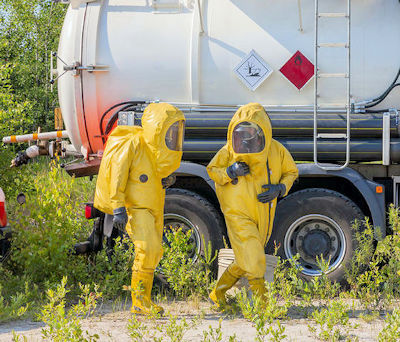33.D Training.
Personnel must comply with the following general and project-specific training requirements:
33.D.01 General training.
General training requirements apply to project personnel exposed to contaminant-related SOH hazards. General training must comply with the following requirements:
- 40-hour off-site HTRW site instruction. Off-site instruction must comply with the 40- hour training requirements in OSHA standards 29 CFR 1910.120 and 29 CFR 1926.65.
-
Instructor qualifications: Personnel responsible for planning and teaching/facilitating the 40-hour training course must be thoroughly knowledgeable of the 40-hour training topics specified by OSHA in 29 CFR 1910.120 and 29 CFR 1926.65 and must possess the knowledge and experience to instruct on each of the topics.
Instructors must retain qualifications for teaching on organizationally relevant 40-hour training safety and occupational health topics by regularly attending and participating in formal industrial hygiene or safety related courses, seminars and conferences. Five (5) days of training over a 5-year period is required.
- (1) 40-hour training course outline for HTRW operations. 40-hour training courses must cover the following topics in a manner that is relevant to organizational operations:
- (a) Names of personnel and alternates responsible for site safety and health;
- (b) Safety, health and other hazards;
- (c) Use of personal protective equipment;
- (d) Work practices by which employees can minimize risks from hazards;
- (e) Safe use of engineering controls and equipment to minimize exposure to hazards;
- (f) Medical surveillance implemented for the protection of employees;
- (g) Decontamination procedures for personnel and equipment;
- (h) Emergency response plan development and implementation for site work;
- (i) Confined space hazards and awareness;
- (j) Spill containment.
- (2) Computer-based interactive 40-hour training. Computer-based interactive training is acceptable as long as the following criteria are met:
- (a) The course must cover each of the topics required by OSHA for cleanup operations 40-hour training. > See Section 33.D.01.a (2);
- (b) Students must be able to ask questions and receive answers in a timely manner from a qualified instructor with hazardous waste site cleanup safety and health experience;
- (c) Students must participate in 16-hours of hands-on exercises to demonstrate equipment use and procedural proficiency.
- Three (3)-Days On-the-Job-Training (OJT). In addition to the classroom training, the training must include 3 days of OJT (in field) experience under the direct supervision of a trained, experienced supervisor.
- 8-hour annual refresher training. Refresher training must comply with the requirements in OSHA standards 29 CFR 1910.120 and 29 CFR 1926.65. USACE employees must comply with local district hazardous waste refresher training policies.
- (1) The 8-hour refresher training course outline for HTRW operations must cover the topics identified in Section 33.D.01.a (2) above. Refresher training courses must cover those topics in a manner that is relevant to organizational operations and must address hazards that were encountered in the previous year:
- (2) Computer-based interactive 8-hour refresher training. Computer based interactive training is acceptable as long as the criteria identified in Section 33.D.01.a (3) above are met.
- Supervisory training. On-site supervisors must comply with the 8-hour supervisory training requirements in OSHA standards 29 CFR 1910.120 and 29 CFR 1926.65.
Knowledge Check Choose the best answer for the question.
33-4. How may days of field On-the-Job-Training (OJT) HAZWOPER training must employees receive in addition to the classroom training?
You forgot to answer the question!

